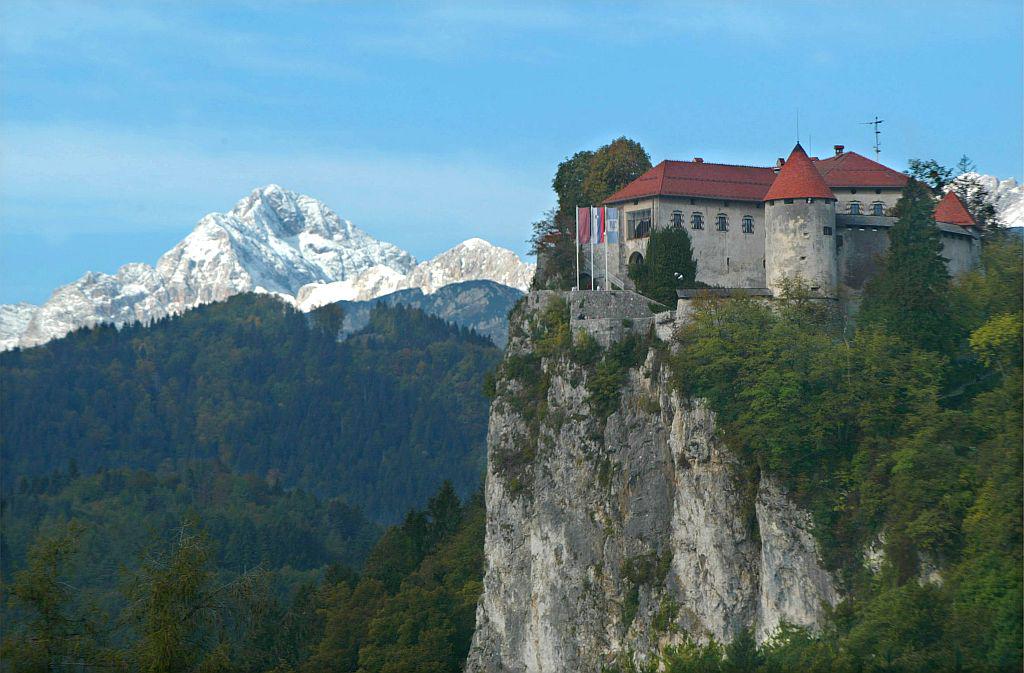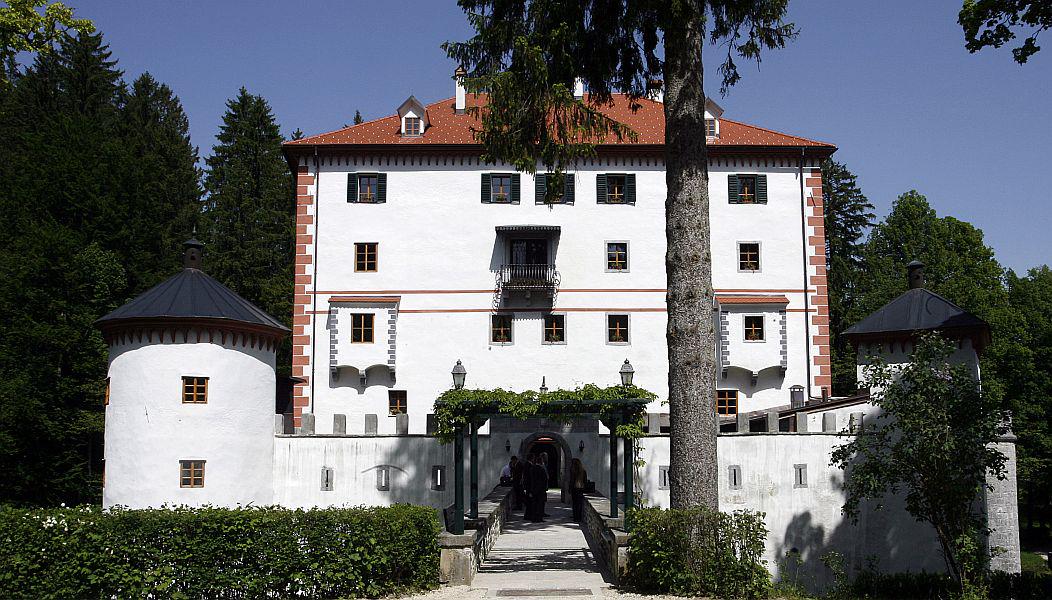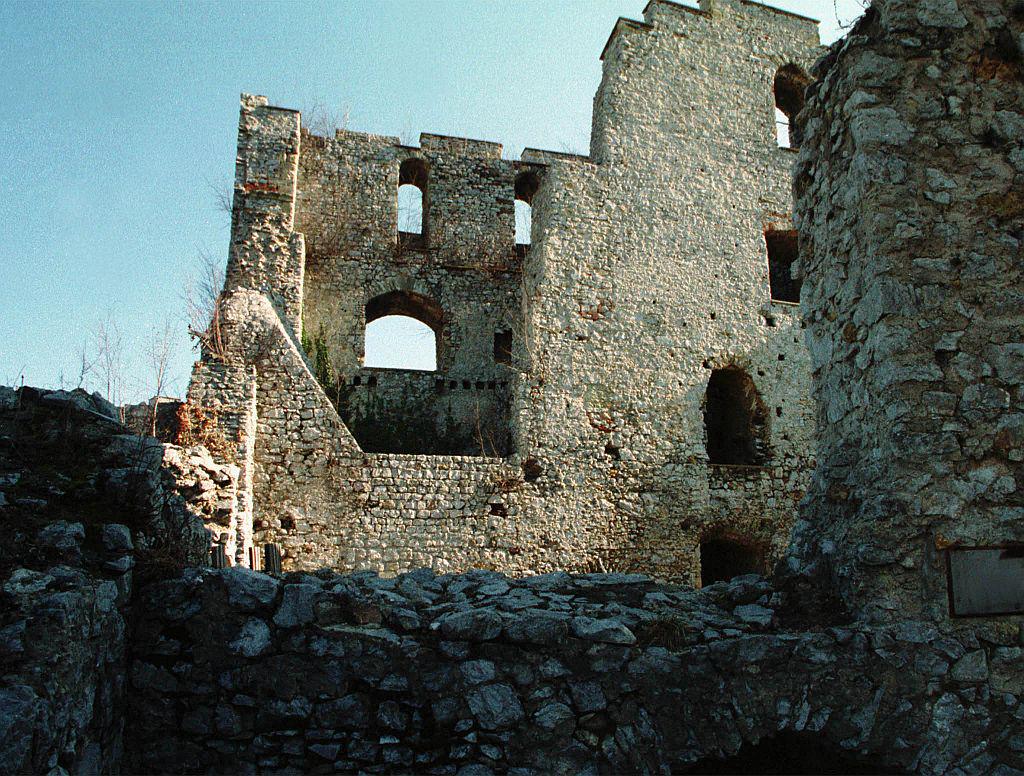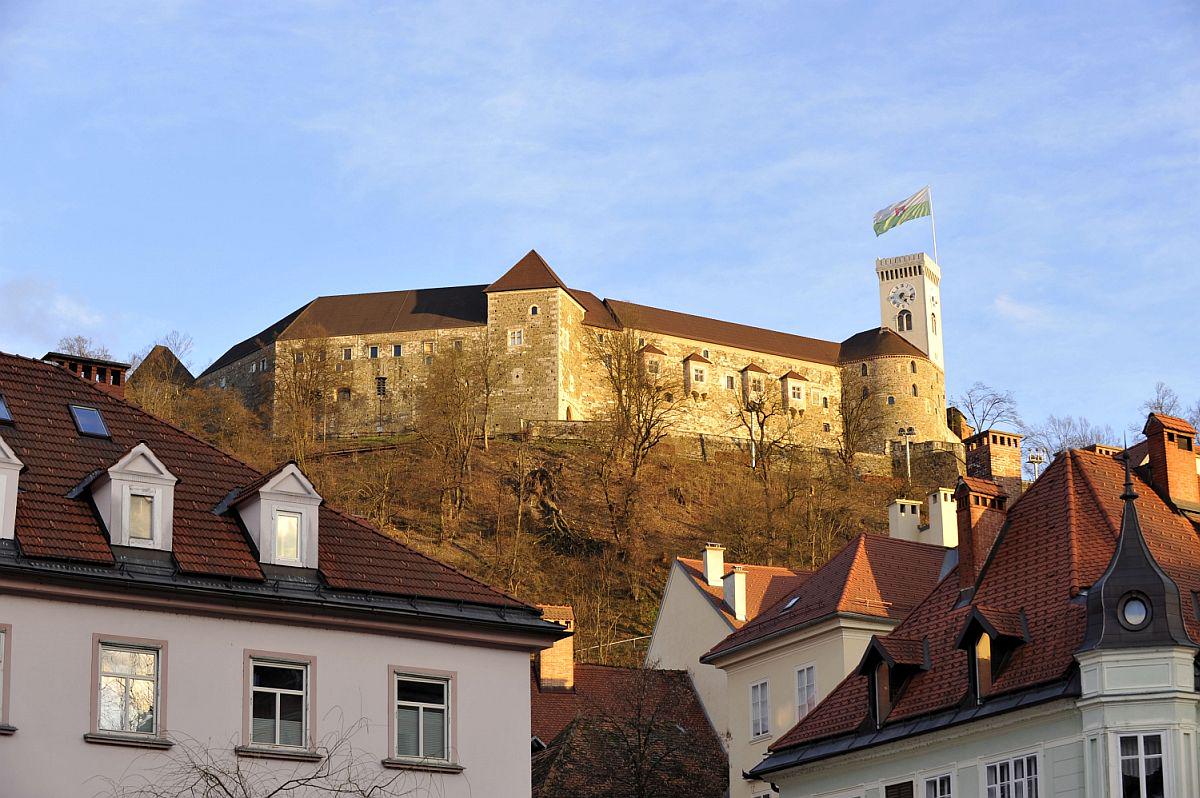



All manner of stories evolved about the castles and the people who dwelled in them, stories which were later embellished, transformed and shared with descendants. Thanks to these tales and legends preserved in the folk tradition, we can to this day relive the events which took place in their grand chambers and halls.
Bled Castle
According to written sources, Bled Castle is the oldest Slovenian castle and was first mentioned as early as in 1011. The castle is situated on a steep cliff rising 130 metres above Lake Bled. Associated with the castle is the legend of Poliksena who was married to Hartman Kreigh, lord of Bled Castle. Kreigh was not a kind master and farmers resisted and complained about him to the bishop and the emperor. And one day, he mysteriously disappeared. The mourning widow collected all her gold and silver and ordered that a bell be cast from the gold in memory of her husband for the chapel on Bled Island. When the bell was being transported to the island, a storm broke out and the boat sank together with the boatmen and its precious cargo. The bell sank into the muddy depths but its peals can still be heard on stormy nights ringing from deep within the lake. Poliksena left the castle and went to a convent in Rome. When the Pope heard about her sad story, he had a new bell cast and had it sent to the island.
Today the castle is associated with much nicer tales and events since it is one of the most popular wedding locations in Slovenia. Remnants of the castle’s distant past are evident only in the castle’s printing works where the reconstruction of Gutenberg’s wooden printing press is on display. The printer demonstrates printing on hand-made paper with historical blocks and lead metal letterpresses.
Celje Castle
Celje Castle is the largest medieval castle in Slovenia and was once home to the renowned Counts of Celje. The Counts of Celje were the most important noble family that ruled over, lived and owned their own land on the territory of what is present-day Slovenia. Its last residents left the castle in 1400 and moved to the Prince’s Mansion (Knežji dvorec) in the town of Celje.
The most famous story connected with Celje Castle concerns the forbidden love between Frederick II of Celje and Veronika of Desenice, a lady of minor nobility. Frederick’s father, Herman II of Celje was particularly opposed to their love affair and had his son Frederick locked in a narrow, 23-metre high tower where he was incarcerated for more than four years. Since then the tower has been known as Frederick’s Tower. Veronika was accused of witchcraft on the grounds that she had seduced and enticed Frederick to the point of obsession. This was the first known witch trial in the territory of the present-day Slovenia. The court pardoned Veronika but her life nevertheless was not spared. Herman II ignored the ruling of the court, and incarcerated her in Ojstrica Castle where she was drowned in a bathtub in 1425.
Idrija Castle – Gewekenegg
Idrija is known for its mercury mine, the second largest of its kind in the world. Due to its rich mining heritage that has been preserved, the town was entered on the UNESCO’s World Heritage List in 2012. Part of this heritage is also Gewekenegg Castle whose construction began some 30 years after the discovery of mercury at the end of the 15th century. This is the only castle in Slovenia which was not intended for feudal nobility but it served as the residence and work place of the director of the mine and its entire administration. It also had a defensive function and was used for storing large quantities of mercury. The castle’s towers were used as dungeons. A large smuggling operation was discovered at the beginning of the 18th century. Along with other smugglers, the cunning Melhiorca, also found herself in the castle’s dungeon. During the trial, she taunted and confused the officials, managed to escape from her confinement but later returned to the castle of her own accord.
Today the castle houses the Idrija Municipal Museum which was pronounced the best European museum of industrial and technical heritage in 1997. The museum presents the 500-year-old history of Idrija’s mercury mine and the town of Idrija itself.
On display in the castle is an exhibition of Idrija lace featuring the history of 300 years of lace-making in Idrija and Slovenia. The Treasure Chest of Lace exhibition includes the largest, the smallest and the oldest examples of lace, including contemporary and currently fashionable pieces.
Ljubljana Castle
Ljubljana Castle is the most identifiable feature of Ljubljana. The fastest way to reach it is by a short ride on the funicular, and by expending a little effort the castle can also be reached along four footpaths. The Viewing Tower offers a 360-degree panorama of the city. Within the grounds of the castle can be found numerous presentations and exhibitions, including the Permanent Exhibition of Slovenian History, the Prison, Virtual Castle and iLjubljana.
The “Time Machine” provides the broadest insight into life and events at the castle, taking visitors through six crucial periods which defined the history of Ljubljana Castle and the development of the city. At each of the “time stations”, visitors meet a character who presents his or her period. The journey starts in the Roman Emona and continues to the period when St George becomes involved in the fights between pagans and Christians and defeats the terrifying dragon. In the Middle Ages Ljubljana Castle sees the arrival of Emperor Frederick III of Habsburg accompanied by ladies-in-waiting. The representative of Napoleon’s Illyrian Provinces is of course a soldier. The 19th century was a dark period for Ljubljana Castle, with its jail and prisoners, while the 20th century is marked by some of the great names among whom the former Ljubljana mayor, Ivan Hribar, stands out in particular. In costume, representatives of each of the aforementioned periods create a special atmosphere, which is both instructive and entertaining.
Mokrice Castle
Mokrice Castle was first mentioned in 1444. It obtained its basic Renaissance features in the 16th century. The history of the castle is denoted by the findings from the period of the Roman Empire when the road towards Byzantium led past the castle and from the period of the Turkish invasions. Later owners of the castle, who were usually noble families, rearranged the castle, introducing parks and gardens. The Von Gagern brothers even painted and wrote novels here.
Several mysterious legends evolved around Mokrice Castle which is situated almost on the border between Slovenia and Croatia. The most famous of these tells of the unfortunate Countess Barbara who was unlucky in love. She became a widow at an early age and then fell in love again with a nobleman who travelled far and wide only one day to never return again. The countess waited for him for many a year, then one spring morning she gave in to her despair and heart-broken climbed to top of the tower and threw herself to the ground below. Although she died, her heart remained alive and can still be found at Mokrice. The story goes than on every 4 December, the feast day of St Barbara, an old cannonball, pushed by the spirit of the unfortunate countess, would roll three times around the castle courtyard.
Today Mokrice Castle is a high-category hotel and the site of protocol events, conferences, meetings and other official receptions.
Ptuj Castle
Ptuj, the oldest Slovenian town, also prides itself on its castle whose origins date back to the 12th century. It had an important role back in the Middle Ages since it was the hub of feudal property of the Archbishops of Salzburg in the Podravje region and enjoyed an exceptional strategic position. The Archbishops lent the castle to the Lords of Ptuj who during their 300-years’ residence in Ptuj founded the Dominican and Minorite monasteries and constructed the pilgrim’s church on Ptujska Gora mountain. Between 1656 and 1802, the Leslie Counts resided in Ptuj Castle. Its last owners, the Counts of Herberstein, lived in the castle from 1873 to 1945, when the castle was nationalised and became, together with its rich furnishings, part of Ptuj Museum.
The latter houses exhibitions on the collection of arms, feudal dwellings, the castle gallery, the largest collection of musical instruments in Slovenia, which includes a very rare Roman tibia flute, and a collection of traditional carnival masks among which the kurenti stand out. Europe’s largest series of paintings with Turkish motifs, the “Turqueries”, from the 17th century documenting the early interest of European intellectuals in foreign cultures is also exhibited at Ptuj Castle.
Predjama Castle
Predjama Castle is the largest cave castle in the world and is listed in the Guinness Book of World Records on account of this unique feature. Just 9 kilometres away from the famous Postojna Cave, the castle sits like an eagles’ nest amid the 123-metre sheer rock face and enthuses its visitors through its impressive location, even before they set foot into what was once an impenetrable fortress. Walking around the castle offers in insight into what it was like to live in the medieval period. It presents the life of a family associated with the castle who sought refuge in the cave and thus had to sacrifice comfort beyond measure.
The legend about the robber baron, Erazem of Predjama, says that he was able to defy the emperor’s army for more than a year. The soldiers besieged his fortress, but he had a secret tunnel in a cave through which he was able to receive supplies. To display his power and ingenuity, he sent his servant with food to the military camp. When he sent ripe cherries into the camp at a time when these were still green in the neighbouring trees, soldiers thought that dark demonic forces were on his side. Erazem later succumbed only due to a trick by his adversaries and his corruptible servant.
Snežnik Castle
Snežnik Castle is one of the few Slovenian castles which can pride itself on the original interior and furnishings of its last owners. The charm of visiting the castle is in the experience of reliving the presence of the former noble family and of the simple people of those parts who lived on the property.
While walking through castle rooms, you are taken back to the time and stories when princes and princesses from Saxony visited the castle. The interior includes authentically decorated drawing rooms, the bedrooms of family members, guest bedrooms, two dining rooms, a theatre room, an evening salon, a library, servants’ quarters, the castle cellar and an Egyptian room which is considered particularly special because of its ambience. In addition to original furniture, paintings, books, ornamental stoves, chandeliers, carpets, numerous useful and decorative items, the castle also houses a wonderful collection of hunting trophies from the period of the last owners.
It is thanks to Count Jurij, who was a military officer, that the castle remains arranged as it was at the time of its last owners; his strict military upbringing was reflected in the accuracy of his records which were learned and unambiguous, so much so that he also introduced them into his family life. The inventory brought to the castle after 1900 was thus labelled with room numbers and on this basis a reconstruction of the arrangement of internal fittings in individual rooms was conducted. This is also a unique example of such labelling in Slovenia.
Velenje Castle
Velenje Castle is situated on a steep rock hill some 60 metres above the town and offers its visitors a view of Velenje in its entirety. Some 233 steps lead up to the 700-year-old castle, which is a typical military and residential fortress whose ground plan was adjusted to the terrain on which it was constructed.
Today the castle houses Velenje Museum with eleven permanent museum and gallery exhibitions. The legend about the beautiful castle chambermaid Kunigunda, who lived at the castle and was able to heal people, predict the weather and so forth with the help of a magic ball, contributes to the mystery of the castle. The lord of the castle accused her of witchcraft and threw her into the well in the atrium of Velenje Castle. Since then she is said to haunt the castle chambers from time to time.
The castle witch from Velenje Castle is brought to life every last week of August in the form of a summer festival of youth cultures which takes place on the streets of Velenje with concerts, theatre and street performances and sports events.
Grad Castle at Grad
Grad Castle, the largest Baroque castle in Slovenia with 365 rooms, is located in the village bearing the same name (grad means castle in Slovenian) and is situated on a steep hill in the Goričko Landscape Park in the Prekmurje region. The castle reached its present size in the 16th and 17th centuries, and it was further extended and renovated in the 18th and 19th centuries. It has been under renovation since 1995. The idea of combining border regions into an area of protected nature and into a park encompassing three countries resulted in seeking state and European funds for the renovation of the castle. The vision in terms of the development of the castle is for it to become a place of relaxation and appreciation of the highest existential values as well as a place to enjoy its magnificent past. The castle is surrounded by a large English-style park. Large tulip trees, plane trees, honey locusts, copper beeches, hornbeams and oaks give a sense of grandeur and enduring longevity.
Brigita Juhart, SINFO

































































